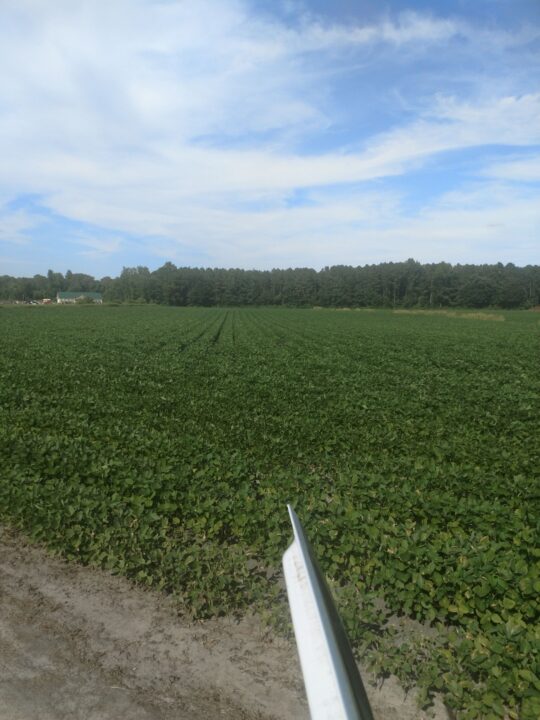Lessons Learned In Dry Farming At Frog’s Leap Winery

For Frank Leeds, Director of Vineyard Operations at Frog’s Leap Winery, dry farming runs in the family. Frank grows 250 acres of organic wine grapes on the Napa Valley ranch that his grandfather purchased during prohibition in 1926. The ranch has never had irrigation. Twenty-five years ago, when Frank started farming, his uncle Roy taught him how to dry farm – a tradition brought over from the “old country” by early Napa Valley pioneers from Spain and Italy. Dry farming, a technique employed in Northern California, the Central Coast, and parts of the Central Valley, relies only on annual rainfall rather than irrigation for a crop’s moisture needs. The soil is cultivated to store winter rains to supply moisture to the crop throughout the growing season. In Napa Valley, dry farming grapes can save as much as 16,000 gallons of water per acre.
According to Frank, “Most of Napa Valley was dry farmed for years and years and then people lost it. The old-timers dry farmed tomatoes before everything was planted in grapes.”
Apart from reduced water use, Frank’s motivation for dry farming is the high quality of grape produced. As Frank explains, “Dry farmed grapes are better quality – more concentrated, great color, balanced fruit, wine in balance with its surroundings, all the “terroir,”1 with roots deep down. All the components of a quality healthy grape you can get with dry farming.”
Water-Saving Practices
- Frog’s Leap relies only on annual rainfall to provide moisture to their winegrapes. They prepare the soil to store natural precipitation, which supplies plant moisture needs.
- Natural soil amendments-compost and cover crops are used at the beginning of the season to improve soil structure and moisture holding capacity and provide essential nutrients to the soil and plants.
- Sprinklers for frost control are used as infrequently as possible. Frog’s Leap waits until it is 32 degrees before applying water, regardless of humidity levels.
Benefits
- Frank estimates that Frog’s Leap saves an estimated 16,000 gallons of water per acre.2
- Forcing the root structures to grow deeper in the soil in search of water produces healthy, vigorous vines and reduces susceptibility to nematodes and diseases, such as phylloxera, that thrive in the top layers of soil.
- Forcing a vine to get moisture deep in the soil also produces vines that last longer. “You get a nice big, healthy, strong grapevine by not giving it a bunch of surface water.”
- Less moisture in the top layer of soil reduces weeds and mildew.
- Continuous cultivation decreases problems from gophers and other pests.
- Dry farming produces intensely colored fruit with concentrated flavor that reflects the local character of the soil and the “terroir.”
- Cultivating the soil and using organic farming techniques such as cover cropping and mulching provide the necessary nutrients for healthy soil and vines with fewer chemical inputs.
- Depending on the crop and region, dry farmed crops can garner higher prices due to consumer recognition and demand.
Costs
- The annual operating costs of dry farming versus irrigating are about the same. Labor costs and fuel use are comparable, since tractor use for the additional soil work required by dry farming is similar to tractor use for herbicide, pesticide and fertilizer applications on non-dry farmed (conventional) vineyards.
- Nonetheless, the costs of establishing a dry farm vineyard are lower due to fewer vines, stakes, and supplies.
- Dry farming requires lower density planting, but the trade-off of lower yields is more intense concentration of flavor and character, which can bring higher prices.
Lessons Learned
- Watch planting density. 40-50 square feet are required per vine – 8×5 at the minimum. According to Frank, “The old-timers said it should be 7×7 and any tighter than that and you will run out of water.”
- Check soil type. The soil structure and moisture holding capacity should be compatible with dry farming.
- Check annual rainfall. Average annual precipitation must be greater than crop moisture needs.
- Focus on drought-resistant varieties. Frank plants with a drought tolerant rootstock, such as St. George, rather than a riparian variety.
1Â “Terroir” is used to describe the characteristics of “place, soil, climate, topography” that contribute to the flavor of a wine.
2 This is a conservative estimate of 20 gallons of water per vine per year with a planting density of 800 vines per acre.










